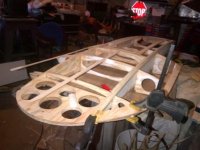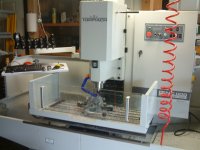Lesson learned
mephiskapheles6 created the topic: Lesson learned
When mixing a two part penetrating epoxy with a high solvent content, do not mix it in plastic cups...it tends to melt the plastic and coat everything with epoxy except what you had intended to coat. 
Please Log in or Create an account to join the conversation.
- mephiskapheles6
-
 Topic Author
Topic Author
- Offline
- Posts: 58
- Thank you received: 0
Steve Seebold replied the topic: Lesson learned
Hopefully, you didn't do it on top of a piece of expensive furniture.
Please Log in or Create an account to join the conversation.
- Steve Seebold
-

- Offline
- Posts: 636
- Karma: 4
- Thank you received: 39
whitefish replied the topic: Lesson learned
Was the material Smith's CPES?
Please Log in or Create an account to join the conversation.
- whitefish
- Offline
- Posts: 155
- Karma: 2
- Thank you received: 25
mephiskapheles6 replied the topic: Lesson learned
It was a System 3 product. Luckily I was in my shop at the time...my drill press table now has a nice sheen to it.
Please Log in or Create an account to join the conversation.
- mephiskapheles6
-
 Topic Author
Topic Author
- Offline
- Posts: 58
- Thank you received: 0
Hugh replied the topic: Lesson learned
Youre not lucky if the drill press table is no longer level. Id clean it with acetone or laquer thinner.
Please Log in or Create an account to join the conversation.
- Hugh
-

whitefish replied the topic: Lesson learned
If the strong solvents don't pop it loose, try Klean-Strip KS-3 Premium Stripper.
Did you find a measure/mix solution? Polyethylene containers might be required. Many
of the small containers that condiments (margarine, yogurt, sour cream, dips, etc.)
are sold in are polyethylene cups.
Maybe this is the System 3 product:
www.systemthree.com/store/pc/S-1-Sealer-c32.htm
The product description sounds like Smith's CPES and the 2 gallon kit has a better
price. Hmmmm.
Sorry to read of your troubles but please accept my sincere gratitude for letting
me know it looks like Smith's CPES finally has a competitor.
My experiences using CPES to seal any wood that goes into service in the marine
environment have all been positive. As soon as I finish coarse cutting all the
structural parts of a hull, I like to coat everything twice with CPES. It can also
be done after the initial frame/skins are assembled. Either way is effective.
Important: if any steaming, soaking or bending of structural members must be
performed, it is usually best to complete all the bending and parts properly
positioned and stabilized before applying CPES.
The other complicating factor with CPES is trying to use it on surfaces that will
be stained - some very funky cross reactions can happen with stains. For any surface
to be epoxied and then painted, it produces incredible results. Also fantastic if a
"naked bilge" is desired - in fact, naked bilge was invented as a result of CPES
being invented (circa 1972) by Steve Smith - no other substance but CPES can make
a long lasting naked bilge.
For toy boat construction, the cost of CPES is minimal as a little goes a long way
and the returns are significant.
Did you find a measure/mix solution? Polyethylene containers might be required. Many
of the small containers that condiments (margarine, yogurt, sour cream, dips, etc.)
are sold in are polyethylene cups.
Maybe this is the System 3 product:
www.systemthree.com/store/pc/S-1-Sealer-c32.htm
The product description sounds like Smith's CPES and the 2 gallon kit has a better
price. Hmmmm.
Sorry to read of your troubles but please accept my sincere gratitude for letting
me know it looks like Smith's CPES finally has a competitor.
My experiences using CPES to seal any wood that goes into service in the marine
environment have all been positive. As soon as I finish coarse cutting all the
structural parts of a hull, I like to coat everything twice with CPES. It can also
be done after the initial frame/skins are assembled. Either way is effective.
Important: if any steaming, soaking or bending of structural members must be
performed, it is usually best to complete all the bending and parts properly
positioned and stabilized before applying CPES.
The other complicating factor with CPES is trying to use it on surfaces that will
be stained - some very funky cross reactions can happen with stains. For any surface
to be epoxied and then painted, it produces incredible results. Also fantastic if a
"naked bilge" is desired - in fact, naked bilge was invented as a result of CPES
being invented (circa 1972) by Steve Smith - no other substance but CPES can make
a long lasting naked bilge.
For toy boat construction, the cost of CPES is minimal as a little goes a long way
and the returns are significant.
Please Log in or Create an account to join the conversation.
- whitefish
- Offline
- Posts: 155
- Karma: 2
- Thank you received: 25
mephiskapheles6 replied the topic: Lesson learned
I just went to the wallymart and bought a couple of cheap glass measuring cups (didn't figure the girlfriend would appreciate me using the ones from the kitchen) and it worked just fine last night.
I got the drill press table cleaned off right after the cup dissolved, so there was no issues with that.
The System three epoxy went on nicely last night, two more coats to go as per product instructions. I will post some pictures when I am finished.
There may be other places to get the System Three, but I ordered mine from Noah's Marine Supply.
I got the drill press table cleaned off right after the cup dissolved, so there was no issues with that.
The System three epoxy went on nicely last night, two more coats to go as per product instructions. I will post some pictures when I am finished.
There may be other places to get the System Three, but I ordered mine from Noah's Marine Supply.
Please Log in or Create an account to join the conversation.
- mephiskapheles6
-
 Topic Author
Topic Author
- Offline
- Posts: 58
- Thank you received: 0
Time to create page: 0.101 seconds
